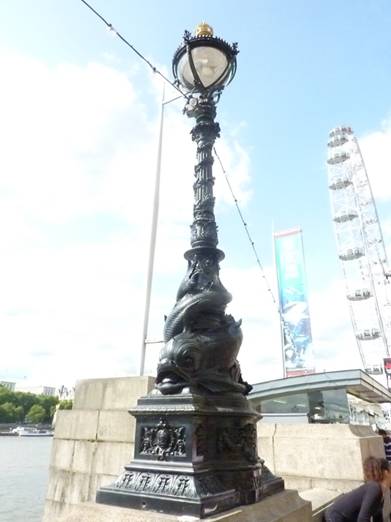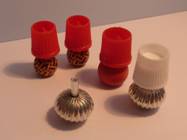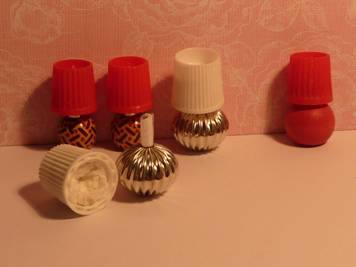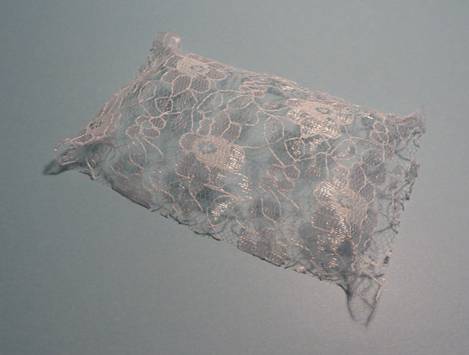
Salty Sam’s Fun Blog for Children
Number 172
Let there be lights
Hello Everyone

As you know, l have an enormous light on the top of my lighthouse – you wouldn’t believe my electricity bill!
l have an electric cooker as well, but l do like the romantic glow of candles. ![]()
At one time, all people had to light their homes at night with were candles and firelight. Throughout history, in fact right up until the mid 20th century, homes have used fires for light as well as heat. lf people couldn’t make their own candles, they were quite expensive to buy, so poor people couldn’t afford to buy many.
From the earliest times people would have known about fire because it would have been created by lightning strikes hitting the forests that they lived in.
The earliest lamps were a kind of candle lamp made by filling a shell, horn or hollowed-out stone with fat or fish oil and inserting a fibre wick into the fat.
Lamps started to be made in pottery in Ancient Greece about 600 BC. The Romans used them too.
The first candles as we know them today were probably invented about 400 AD but weren’t commonly used in people’s homes until the 14th century. The best ones were made of beeswax but they were expensive. Cheaper ones were made from animal fat called tallow. They were smelly and produced a sooty smoke.
Candles that were used in churches to represent the ‘light of God’ were very good quality and didn’t produce black smoke. Monasteries kept bees in hives to produce all the beeswax they needed for the monks to make these candles.
Another way to make a lamp was to peel the outer coating from a rush and soak the inner pith in melted fat. A type of wick was created. This was then suspended in a metal holder and the top of this rush light was lit. lt acted just like a candle but without the bulk of wax around it. This could easily be made by people in their homes. They were much cheaper than candles.
Most domestic chores were carried out in the hours of daylight. Candles did not produce strong light compared to modern lighting.
Later, from the middle of the 1800s, candles were made from paraffin. ln other parts of the world, cinnamon and olive oil could be used.
The oil lamp developed over the next few hundred years; paraffin could fuel these too. Paraffin is a product of oil and made candles odourless.
Metal and glass were used to make these lamps more sturdy and if people wanted to make their light more intense to work by, they used water (often melted snow water because it was so pure) inside a glass receptacle next to the lamp. As the light shone through this water-filled ball, it acted as a magnifier.
Gas lighting was a major step forward. Gas lights lit the streets of London from about 1813/14 and by 1823, 215 miles of London streets were lit by gas lights. Before that, it was the law that everyone should burn a candle in a holder outside their house. Gas lamp lighters were employed to light the lamps at night and switch them off in the morning and they could earn extra money by tapping on people’s bedroom windows with their long poles to wake them up for work – a sort of early alarm call.
Gas was pumped into houses through pipes and the lamps on the wall could be controlled easily. Gas lights also meant theatres and other public places could be lit making the world of entertainment more accessible in the evening.
Theatres’ stages were lit by limelight as well. These lights shone very brightly.
Thomas Drummond invented limelight in 1826. He discovered that when a piece of lime was heated in an oxygen and hydrogen flame, it glowed brightly. ln fact, in one experiment, he noted that with the addition of a reflector, the light travelled 95 miles!
Later, hydrogen was replaced by coal gas, but limelight was used in London theatres up until 1910 and of course we still use the phrase ‘in the limelight’ to mean living in the public eye – just like the old music hall (theatre) stars did.
You may be surprised to hear that there are still some gas lamps in the streets and parks of London – and there is still a small group of gas lamp lighters employed to light them every evening. Many of these lamps are one hundred years old.
ln 1832, Michael Faraday announced that he had changed magnetism into electricity and so began the era of electric motors and generators.
Electricity was available in homes from 1900, but it was many years before every house had transferred from gas light to electric light.
The electric light had been invented by Humphry Davy in 1800; it had taken one hundred years for that invention to be available to the masses.
Nowadays, we can use solar panels, water wheels and wind turbines to generate our own electricity and not have any electricity bills at all!
Maybe l should start looking into that…
Bye bye everyone – don’t forget to subscribe to my blog!
lf you like my blog, please support it by telling all your friends and followers about it.
Thank you!
And see you again next Fun Friday!
Love and kisses
Salty Sam

www.christina-sinclair.com


Bill and Bob’s Joke of the Week![]()
![]()
Bob: What did one magnet say to the other magnet?
Bill: l don’t know. What did one magnet say to the other magnet?
Bob: l find you very attractive!

Salty Sam © Christina Sinclair 2015
Unauthorized use and/or duplication of material from this blog without express and written permission from this blog’s author and owner is strictly prohibited.
Links may be used to www.christina-sinclair.com

Picture Gallery

A basic pottery lamp

A rush light

A Victorian oil lamp

A street gas lamp

Wall gas light

A limelight

Michael Farraday

A Davy lamp

Humphrey Davy

A selection of Roman terracotta lamps
One is shaped like a dolphin
Terracotta is a type of pottery

A multi-nozzled Roman terracotta lamp

This Roman oil lamp is shaped like a foot made AD 50-100
Made in Italy but it was found in Libya

Roman lamps
A terracotta candle stick from the 2nd century, a terracotta lamp shaped like a bull’s head, a three wicks bronze lamp from the 2nd century and a bronze lantern lamp for use outdoors from the 1st century
(British Museum)

The bull’s head has a lot of detail on it

A 17th century sideboard with candle sticks

From the late 17th century, candle sticks were placed on mantle pieces too

Candlesticks were shaped so that they were easy to hold
They were carried from room to room as people walked around the house in the dark
and placed on a flat surface like a table or mantle piece

A late 17th century candle holder with glass cover

A candle inside a lantern in an old shop

A hand-held electric lantern

A Victorian ceiling light

There are very few gas lamps around today

Victorian streets were more dimly lit than modern ones

The lights inside were dimmer too
(you can see the pipes that the gas travelled along)

An early 20th century light

Electric street lamp

Electric lights made cities much brighter at night (1930s)

These gas lights have flames at the top

They are fed with gas through pipes

Each lamp has a pipe at the back

An ornate street lamp on Westminster Bridge

A street light in The Mall with a ship at the top

A dolphin lamp by the River Thames

A gas light flame

A gas light in Trafalgar Square

A Victorian street light

Ornate street light by Trafalgar Square

The base of the lamp

A sodium-vapour is a gas discharge lamp that uses sodium in an excited state to produce light – low-pressure sodium lamps are high efficient light sources (that means that they don’t use too much electricity) but they don’t throw out much light but this makes them adequate for street lights and especially suitable for places where there are space observatories because they don’t emit as much light ‘pollution’ as stronger lights – you may have yellow lights like this in the street where you live.
(You can sometimes see gas moving round inside a lamp in some of the fluorescent light strips in buses –
have a look next time you travel in a bus at night).


 THE SALTY SAM NEWS DESK
THE SALTY SAM NEWS DESK

Bill and Bob have lots of light bulb jokes they are very eager to tell you, so I thought I might as well give up the News Desk to them again this week.

Here are some of them:-
How many fishermen does it take to change a light bulb?
Four, one to change it and three to argue over how big it is.
![]()
How many antiques dealers does it take to change a light bulb?
Six, one to change it and the other five to argue how old it is.
![]()
How many circus performers does it take to change a light bulb?
Five, one to change it and four to hold the safety net.
![]()
How many teachers does it take to change a light bulb?
None, they’d give the job to their students as an exercise.
![]()
How many astronomers does it take to change a light bulb?
None, they prefer the dark.
![]()
How many misers does it take to change a light bulb?
None, they’d prefer to sit in the dark too.
![]()
How many accountants does it take to change a light bulb?
None, there is no money in the budget for new light bulbs.
![]()
How many magicians does it take to change a light bulb?
It depends what you want it changed into?
![]()
How many philosophers does it take to change a light bulb?
Now that is an interesting question.


Working late into the night on my blog by candlelight

I just wanted to say something quickly about GDPR which has been in place since 25th May 2016 and came into enforcement last week on 25th May 2018.
The General Data Protection Regulation (GDPR) is a law produced as a result of many years of discussion between EU member states to make sure that they all operate under the same law concerning privacy and security of data.
If you subscribe to this blog, your e-mail address and no other details about you are stored on my website. This part of the website is not on public view. It is kept in what is like a back office that you can’t see called a dashboard. I can load more posts for you to read through this dashboard.
I do not share your e-mail address with any other parties (that means people or companies).
I do not bombard you with e-mails.
You will receive posts automatically every week when you subscribe. They will come through to the e-mail address you give. That is all.
My website is managed by a company that operates under GDPR regulations and continually strives to maintain security and privacy on all the websites it controls on its servers.

*********************
TO ADVERTISE ON THIS BLOG
PLEASE CONTACT:
christina.sinclair.ads@aol.co.uk
*********************


Crafty Tip
This is an easy way to make a table lamp for your dolls’ house.

Scrunch up a tiny piece of tissue paper or kitchen roll into a tube top (this could be from a tube of toothpaste or puree used in the kitchen) to make a lampshade and attach to a metal or wooden bead with flat ends with a tiny roll of silver foil.
Of course they won’t light up; but they do look quite realistic.



![]()
And here is an idea for a table cloth to go with it.
Cut a piece of lace that will not fray to the size of your dolls’ house table with an overhang. Pinch the corners and sew into place to keep the sides of the cloth hanging down the sides of the table. Make sure all the sides are even.

![]()
This is a knitting pattern to use to make a towel and bath mat set for your dolls’ house
TOWEL
Using 3¼mm knitting needles and white 4ply yarn cast on 8 stitches quite loosely
Knit 1 row
Knit 1 row
Knit 20 rows of garter stitch slipping the first stitch of every row
Cast off and run the ends of the yarn down each side using a knitter’s yarn needle to neaten the edges.
BATH MAT
Using 3¼mm knitting needles and green 4ply yarn cast on 10 stitches quite loosely
Knit 1 row
Knit 1 row
Knit 28 rows of garter stitch slipping the first stitch of every row
Cast off and run the ends of the yarn down each side using a knitter’s yarn needle to neaten the edges.
Decorate the mat if you would like to.

![]()
There is also a pattern for a dolls’ house blanket on Blog Post 97.


BLOW MY FOGHORN!!!

PLUS
Salty Sam fans can join in with their comments and share them with children all over the world. You will need to ask permission if you are not an adult.
Enter your e-mail address to subscribe to my blog and receive new Salty Sam Blog Posts for free by e-mail every week. Your address will be kept private and will not be shared with any third party.
Sign me up at the side bar




lt’s the Weekend!

HOW TO MAKE SlLHOUETTES OF YOUR FAMlLY
In the late 1700s, making silhouette portraits of people became very fashionable.

There are two ways you can do this.
Get your subject to sit in a darkened room and shine a torch onto the side of their face. Trace their profile shadow onto a piece of paper. You might find it easiest to tape your paper onto a window and you will need to position your subject, light beam and paper well in order to get the right effect.
Otherwise, you could take a photo of the side of their face and draw the line you see onto a piece of paper.
Put the white paper on top of a sheet of black paper and secure them well with tape around the edges.
Holding the paper securely, cut out the silhouette and mount it onto another piece of paper and then into a frame.
Or cut out the shape drawn on the white paper and draw around it using pencil on some black paper or thin card. In good light you should be able to see a pencil line on black paper.
If you get good at making silhouettes, you might want to try and make your own pictures – they can look very effective.
Of course you can also make pictures in white paper and put them on black backgrounds.

Jane Austen the novelist

If your subject won’t keep still, use a photo as a guide
Small lines like whiskers will have to be drawn rather than cut

A paper-cut by Wilhelm Gross
(This kind of intricate work needs to be made by using a modelling knife,
if you are old enough to use one)
If you wanted to make a picture with this many elements,
you could make the figures separately and then put them together in one compilation

Portraits were displayed on walls and mantle pieces
Please note that the material on this blog is for personal use and for use in classrooms only.
It is a copyright infringement and, therefore, illegal under international law to sell items made with these patterns.
Use of the toys and projects is at your own risk.
©Christina Sinclair Designs 2015





Hey, terrific blog!
Thanks!